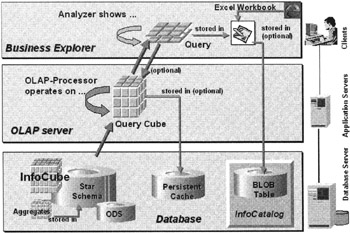Data Flow in BW
When the user launches a report from BEX Explorer, it starts a BEX Analyzer session and opens an Excel workbook that contains an embedded BW query. BEX Analyzer sends a request to the BW application server for relevant data. If this is a new query for a user, no data is found at the application server level. The query is then pushed further down to the database server to fetch a result set from an InfoCube or an aggregate associated with an InfoCube.
The database server fetches data from an InfoCube and hands it over to the application server, where it restructures the table-oriented data to a multidimensional structure, called a query cube, as shown in Figure 2-15.

Figure 2-15: Data Flow Within SAP BW 1.2B.
A query cube is the subset of an InfoCube, which is specified by the query. Some characteristics are restricted to specific values, whereas some are not chosen in the query. For this reason, the size of the query cube is much smaller than the actual InfoCube.
| Note | A query cube is unique to a user request and, hence, is not shared by other users. If several users start the same query, all will have their own unique query cubes built at the application server. This is because the result set may vary based on selected dimensions or special filters. Also, each will have full control on how to navigate through the query cube (slicing and dicing) without interfering with analytical work done by others. |
| Note | As the number of query cubes increases, the application server may run out of memory very quickly. For this reason, the application server for SAP BW requires more memory (2 GB) as compared to traditional SAP R/3 for OLTP instance. Moreover, the SAP BW application server needs more computer power due to data aggregations and computation requirements to satisfy end-user data analysis needs. A dual high-speed processor is suggested for an SAP BW application server. Chapter 16, "Managing SAP BW-Performance and Tuning," describes SAP BW sizing requirements. |
Once a query cube completes, a portion of data from the query cube is pushed up to load data in Microsoft Excel worksheets based on the current end user's data view, as shown in Figure 2-15. From this point on, the end user performs typical slice-and-dice and drill-down data analysis using BEX Analyzer functions. If the user needs additional drill-down data that is not presented at a given time, the request is sent to the query cube to send data in the spreadsheet for drill-down analysis. If that detailed data is not in the query cube, the OLAP processor will refresh the query cube from the InfoCube. This navigational and data refresh process continues until the data requirements are met at each level.
| Note | A query cube always relates to only one InfoCube. In other words, you cannot build a query cube that gets data from more than one InfoCube. The cross-lnfoCube queries are supported in the BW 2.0A release in the form of MultiCube implementation. However, if you are using SAP BW 1.2B, and you really need data from multiple InfoCubes, a temporary solution can be built by embedding SAP BW queries from different InfoCubes in individual spreadsheets of a workbook. Then you can manipulate data from such spreadsheets using Microsoft Excel macros or VBA code to build another spreadsheet to display a final data set, charts, and graphs. Chapter 11 describes how to build query and workbook solutions. |
It is not expected that analysts will complete all the data analysis in one session. SAP BW users have a choice to save the result set of their analytical work at any time and in any state. They can save it back in the SAP BW server or on their desktop in the form of a Microsoft Excel workbook, as shown in Figure 2-15. This enables them to restart their analytical work where they left off or mail the results to other users if needed.
| Team-Fly |
EAN: 2147483647
Pages: 174